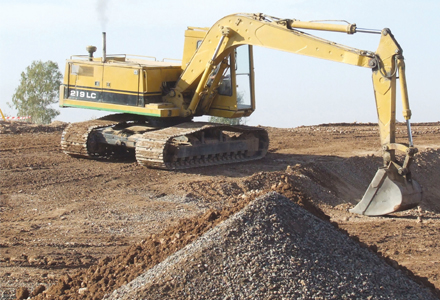
Hydraulic excavators are now the construction or quarry workhorse, but the concept took a while to catch on
Hydraulic excavators are now the most widely used of all off-highway machines but that the hydraulic excavator has become, effectively, ubiquitous is of note. The current generation of hydraulic excavators are descended from machines developed 60 or so years ago, which is a considerably shorter time than for other pieces of equipment, such as the bulldozer or grader.
The first known hydraulic excavators were rail mounted machines, with two built in the UK in 1882 and 1914 (by different firms) and five made in the US starting in 1897. None of these machines were particularly successful, due in part to the use of water for transmitting power, as well as to the non-availability of effective seals.
It was not until the 1940s that hydraulic excavators began to be developed in the US, Italy and France that used oil instead of water.
An American called Ray Ferwerda developed a hydraulic excavator design that was then bought by Warner & Swasey in 1946. This design went on to become the Gradall range, which is still produced and features a boom with hydraulic extension and a tilting bucket.
The Milwaukee Hydraulic Hydrocrane design, also launched in 1946, used a boom and dipper configuration more similar to those of modern machines. This design was then bought by Bucyrus Erie in 1948 which continued development (and production) of the concept.
The Italian Bruneri brothers built their machine in 1948, mounting their excavator on a military truck chassis but after developing a few more prototypes and refining the concept, they became disenchanted with the lack of market interest and sold the design rights to a French company called SICAM in 1954. Also in 1948, the French company
By the early 1950s, several firms were making hydraulic excavators, including Bucyrus Erie, Potain, SICAM (which used the Yumbo brand) and Warner & Swasey. However, all of these machines were wheeled (and most were truck-mounted). Other firms entering the market in the 1950s were Atlas and
The machines of the 1950s were however limited by the reliability of hydraulic systems of the time, which left a lot to be desired in terms of reliability. Only in the 1960s did more effective hydraulic sealing systems become widely available, which helped fuel a massive expansion in sales of crawler-mounted excavators.
By this time the early players such as Atlas, Bucyrus Erie, Demag, Liebherr, Poclain, Warner & Swasey and Yumbo had all started building crawler excavators and the number of manufacturers began to swell too with the addition of firms including
It is worth noting that Hitachi developed its excavators in house, unlike the other Japanese firms which licensed technology from other companies. Mitsubishi was a licensee of French firm SICAM's Yumbo machines for instance (along with British company Priestman and Spanish company TUSA). Meanwhile Kobelco was a licensee of P&H,
Excavators continue to be built in France, Germany, Japan, the UK and the US, while firms in South Korea and China have also entered the world market. And in more recent years, developments in hydraulics have moved leaps and bounds from those early, and not at all oil-tight, machines. It is worth noting that today, a high percentage of the technological innovation in hydraulic excavator design has its origins in Japan.














